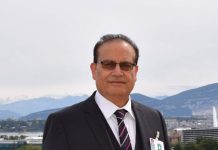Ahsan Hamid Durrani
In the heart of the Caucasus, amidst the echoes of a turbulent past, lies the Karabakh region of Azerbaijan. It was a land scarred by conflict, where the shadows of Armenian occupation once loomed large. Yet, it was also a land of resilience and hope, where the spirit of its people soared above the ruins left by the ravages of war.
My journey to Karabakh was not merely a trip but an expedition of sorts, a quest to bear witness to history in the making. Accompanied by a group of international visitors, I traversed through the remnants of Armenian occupation, a grim reminder of the toll that conflict can exact upon a land and its people.
Arriving in the city of Fuzuli, I was greeted by the desolation of a community reduced to ruins. Mosques, churches, homes, and schools lay shattered, a testament to the rampage unleashed by the departing Armenian forces. Watching the ghostly ruins of this city, I felt the weight of history pressing down upon me, the echoes of the past whispering tales of sorrow and loss.
But amidst the rubble, a flicker of hope emerged as I traveled deep into the city center. New buildings rose defiantly from the ashes, a testament to the indomitable spirit of the Azerbaijani people. Fuzuli was not just a city in ruins; it was a canvas upon which the resilience of a nation was painted with blood and sweat. As locals toiled tirelessly to rebuild their shattered lives, I witnessed the birth of a new chapter in the city’s history—a chapter defined not by destruction, but by resilience and renewal. More than 400 families have started living in this city.
Venturing further into the heart of Karabakh, I arrived in the enchanting city of Shusha, a jewel nestled amidst lush green mountains and pristine snow. Here, amidst the echoes of a bygone era, I witnessed the rebirth of a cultural capital reclaiming its rightful place in the annals of history.
The Yukhari Govhar Agha Mosque, once desecrated by Armenian forces where they housed cattle and pigs, stood tall once more, its walls echoing with the prayers of the faithful. The mosque was completely restored by Azerbaijani authorities. Nearby, a new luxury hotel stood as a beacon of hope, a symbol of Shusha’s resurgence as a vibrant tourist destination. Yet, amidst the gleaming facades and bustling streets, reminders of the city’s tumultuous past lingered— houses and buildings destroyed by the occupation forces of Armenia.
In Shusha, I delved into the rich tapestry of Azerbaijani culture, immersing myself in the legacy of a renowned singer Murtuza Mammadov, affectionately known as Bulbul by the locals. His museum, a tribute to his enduring legacy, stood as a testament to the resilience of the human spirit—a spirit that transcended the boundaries of time and conflict. His vandalized statue stood beside a newly erected one bearing testament to the scars left Armenian forces in an effort to destroy the soul of this city.
As I gazed upon the snow-capped peaks of Karabakh, I couldn’t help but marvel at the transformation that had taken place. Where once the echoes of gunfire had pierced the air, now the strains of folk songs resonated, a celebration of newfound freedom and unity. New constructed roads, monuments, and residential and commercial buildings lifted the spirit of the city. It’s indeed a wonderful achievement that such progress has been achieved in merely a span of three years. The Azerbaijani flag, once a distant dream, now fluttered proudly atop the lofty mountains, a symbol of hope and reconciliation.
My journey through Karabakh was more than just a voyage through a land scarred by conflict—it was a testament to the resilience of the human spirit, a reminder that even amidst the darkest of times, hope can still bloom. As I bid farewell to this land, I carried with me not just memories, but a renewed sense of hope for a future where peace and prosperity reign supreme.

















